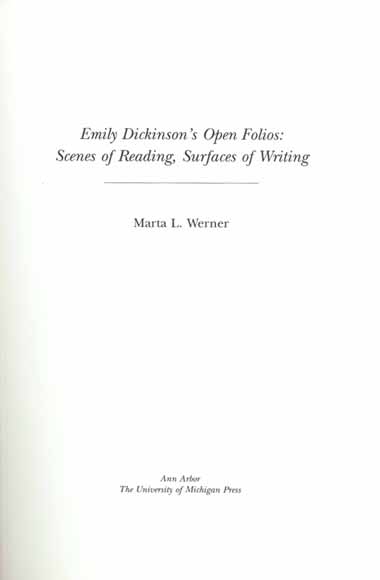herself"
(16). In Franklin's dating schema the fascicles span the years 1858
to 1864; the sets range in dates from 1864 to the mid-1870s.
7. This
phrase is the title of Sharon Cameron's recent book Choosing Not
Choosing: Dickinson's Fascicles (Chicago: University of Chicago
Press, 1992). Cameron's work-the first full-scale critical study of
the packets-is a major projection of Dickinson scholarship.
8. Jonathan
Arac, "F. 0. Matthiessen and American Studies,"
Critical Genealogies: Historical Situations for Postmodern Literary Studies
(New York: Columbia University Press, 1987), 159.
9. Cameron,
Choosing Not Choosing, 24.
10. Rainer
Maria Rilke, 'The First Elegy," in The Selected Poetry of
Rainer Maria Rilke edited and translated by Stephen Mitchell,
with an introduction by Robert Hass (New York: Vintage Books, 1984), 155.
11. See
Susan Howe, "Some Notes on Visual Intentionality in Emily
Dickinson," HOW(ever) 3,110.4 (1986): 11-13; "These
Flames and Generosities of the Heart: Emily Dickinson and the Illogic
of Sumptuary Values," Sulfur 28 (Spring 1991): 134-55 and The
Birth-mark: Unsettling the Wilderness in American Literary History
(Hanover, N.H., and London: Wesleyan University Press, 1993); Martha
Nell Smith, Rowing in Eden: Rereading Emily Dickinson (Austin:
University of Texas Press, 1992); and Sharon Cameron, Choosing Not Choosing.
Mary Jo Salter's essay "Puns and Accordions: Emily
Dickinson and the Unsaid" (Yale Review 79:188-221) and
Jeanne Holland's essay "Scraps, Stamps and Cut-Outs: Emily
Dickinson's Domestic Technologies of Publication," in Cultural
Artifacts and the Production of Meaning, edited by Katherine
O'Brien O'Keefe and Margaret J. M. Ezell (Ann Arbor: University of
Michigan Press, 1994) both add significantly to our understanding of
order in Dickinson's writings.
12. Cameron,
Choosing Not Choosing, 6.
13. Howe,
The Birth-mark, 2.
14. David
Porter, Dickinson: The Modern Idiom (Cambridge, Mass.:
Harvard University Press, 1981), 7.
15. James
Clifford, The Predicament of Culture: Twentieth-Century
Ethnography, Literature and Art (Cambridge, Mass.: Harvard
University Press, 1988), 229.
16. Thomas
H. Johnson, "Establishing a Text: The Emily Dickinson
Papers," Studies in Bibliography (1952-53): 32; reprinted
in Art and Error: Modern Textual Editing, edited by Ronald
Gottesman and Scott Bennett (Bloomington: Indiana State University
Press, 1970), 145. Though I depart from Johnson's conclusions,
particularly his claim that it is "theoretically possible, if
enough manuscripts existed, and if each manuscript used enough
letters in sufficient combination, to track down the dates of the
limits of composition within a given week" (29), his essay
provides invaluable information about the textual dilemmas facing the
editor of Dickinson's poetry.
17. See
Donald H. Reiman, "The Four Ages of Editing," Romantic
Texts and Contexts (Columbia: University of Missouri Press,
1987), 98: "I denominate this school of textual scholars the
Brazen Age of editing because of the too sanguine hopes they, at
least for a time, entertained about the results obtain-


